How to distinguish a diseased root from a healthy one?
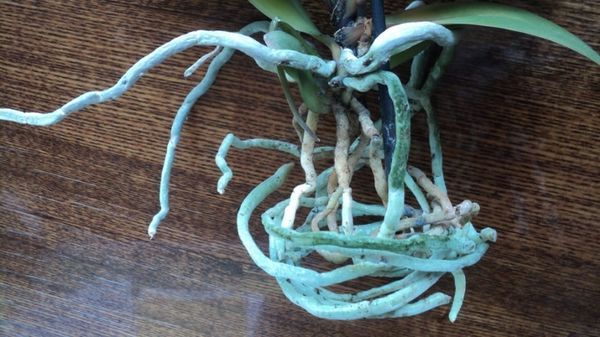
Healthy root.
Healthy root:
- Has a growing tip;
- Has a light green (after watering) or silvery (before watering) shade of velamen;
- Solid;
- Elastic, when you click on it, nothing is highlighted;
- A healthy root mass does not emit a putrid odor;
- If they are inside the substrate, they may take on a light brown tint, but they are still elastic.
As you can see from the photo of the diseased root:
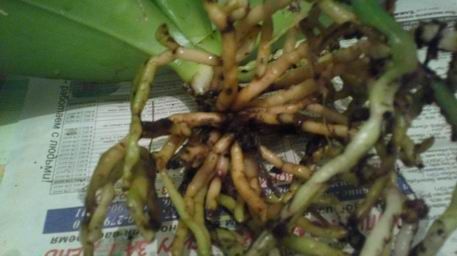
Sick orchid roots.
- He is affected by a fungus;
- There are black spots of decaying places along the length of the root;
- When pressed, a liquid with a putrid odor is released from the root;
- When pressed, the velamen is removed from the guide.
The main cause of root mass disease is the constant flooding of the roots with unsuitable water. Not only do they not dry out between waterings and do not participate in photosynthesis, but also hard water clogs the capillaries that conduct water to the middle of the plant.
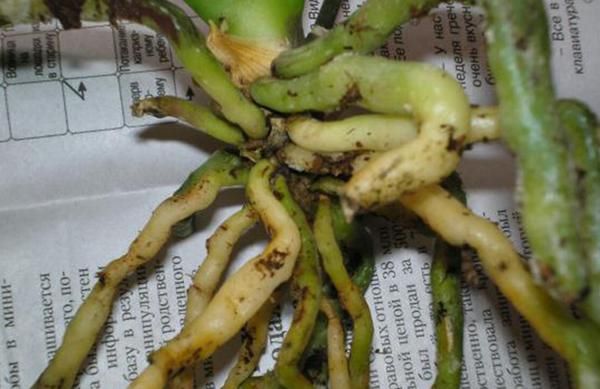
Unhealthy roots.
In this case, water accumulates in the roots, and its excess leads to decay. Also, the roots can die if fertilizing is carried out with a fertilizer not intended for orchid plants or if the dosage exceeds that indicated in the instructions on the fertilizer package.
IMPORTANT! It is necessary to organize watering and feeding in such a way that the orchid does not suffer from its root system.
Rotting roots.
What if there are no buds?
Why do orchid leaves wither: causes and methods of dealing with them
The plant does not release more than 3 flower stems. Usually there is 1 shoot with blossoming flowers. The age of the culture and the presence of 8-10 leaves in the outlet are conditions when 2 or 3 peduncles are formed, causing stress in the orchid. Often, active flowering is accompanied by a weak culture. The creation of suitable conditions by experienced florists causes the appearance of 2 peduncles on the orchid.
Flower stalks on an orchid
Many orchid lovers complain that their beauties are "sitting" in place, not pleasing with their flowering for several years. What should be done in such a situation for the plant to shoot an arrow? For starters, just try to rearrange the flower to a new location. If it does not help, then there are several options for "shock therapy" that experienced florists strongly recommend.
Temperature drops
- Rearrange the flower with the pot in a place where there is a temperature difference of 5C - 7C: it should be cool at night, warm during the day. The best place is a balcony, veranda.
- It is imperative to check for drafts, since the plant does not tolerate them and may die.
- Move the container with the epiphyte to a darker place than what he is used to.
- Reduce as much as possible, and sometimes completely stop watering the plant, giving it a kind of "drought".
- After 1.5-2.5 weeks, carry out the first moderate watering.
-
Reduce watering of an orchid in half: for example, if watering was carried out 1 time in 5 days, then you need to start watering the plant 1 time in 10 days.
- Moderate watering with boiled water at room temperature is recommended between intervals of "drought".
- You cannot spray the plant at this time, moisten the substrate from the spray bottle.
Re-flowering
What species are inherent in?
All types of orchid plants can bloom 2-3 times a year. It all depends on the age and conditions of detention. If the flower is well developed and has a large number of leaves with good turgor, then it may well overpower the re-formation of buds.
The necessary conditions
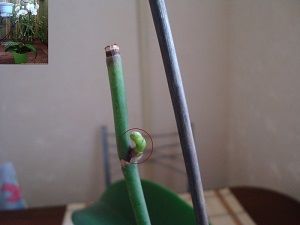 A repeated flower shoot will develop from a waiting bud, which is located on an old faded peduncle.
A repeated flower shoot will develop from a waiting bud, which is located on an old faded peduncle.
First, the bud wakes up and a small beak of a small sprout appears. With good care, after 5 days, the shoot can grow by 2 cm and it will be clear that this is a baby or a flower shoot.
It may be shorter than the main shoot, but it will also form standard sized flowers belonging to this cultivar.
Factors affecting bud re-formation:
- In anticipation of re-flowering, you do not need to move the orchid relative to the light mark. That is, if it becomes necessary to move a flower, for example, deep into the room, it is transferred and placed on the same side in relation to the lighting that it stood with;
- The illumination of the place where the flower is located must be at least 12 hours a day, and the sun's rays must be necessarily diffused. If, for some reason, there is not enough lighting, it is necessary to organize additional lighting with the help of special lamps for plants;
- In order for the flower arrow to move into growth, one must not forget about the humidity of the air and night temperature drops. They should be within 5 degrees Celsius.
IMPORTANT! By adhering to these recommendations, it will be possible to see the re-dissolution of the orchid flowers.
Potential risks
Many growers are afraid of re-blooming of the orchid, believing that this may ruin it. But this is not the case. A well-developed plant, undamaged by a disease or pest, can bloom again, delighting the grower with its flowers.
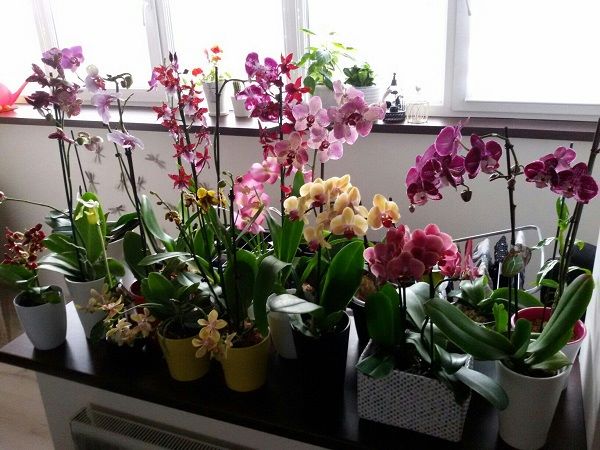
Healthy, well-groomed orchids will not hurt to re-bloom.
However, there is a certain risk to the plant with repeated flowering. If it is weakened due to:
- long flowering with 2 peduncles;
- resuscitation of leaves or root system;
- moving;
- any disease or infestation by any harmful insects.
Due to these reasons, the plant will be weakened and will not be able to pull out the growth of a new flower shoot. As a result, it can turn out to be short with 2-3 buds. But even giving its strength to this flowering, the flower can lose a couple of leaves to form a flower shoot.
Under what circumstances is it not recommended?
 If the orchid is weakened for any reason, then the peduncle must be cut off after the first flowering.
If the orchid is weakened for any reason, then the peduncle must be cut off after the first flowering.
Because the acquired flowering plant already spent a lot of effort on transportation during flowering, plus it went through stress during the sale in the store. It is already weakened and blooms all this time.
After flowering, it is transplanted into the correct substrate, and at the same time, damage to the root mass is often seen due to frequent watering. Therefore, during transplantation, it is better to completely remove the flower arrow and begin to restore the internal strength of the plant.
Care
If a new shoot has appeared on a flower shoot that was cut off after flowering, then the flower must be reconsidered the conditions of detention so that it does not dry out this young sprout.
Therefore, it is necessary to increase the lighting, if this happens in winter, add moisture with the help of placed containers with water and start feeding the plant with fertilizers intended for this type of plant.
IMPORTANT! Top dressing is applied only to wet roots so that the velamen does not burn on the root mass.
If the arrow is well developed, does not suffer after a long primary flowering and a shoot has appeared on the peduncle - what to do? The orchid must be provided with:
- good lighting with diffused sunlight;
- humidity at 75%;
- timely watering;
- top dressing with specialized fertilizers for orchids.

Proper watering is one aspect of successful flowering.
When the first buds begin to set, top dressing is removed from the plant's diet.
Useful videos:
This video describes and shows many examples of nascent peduncles in orchids:
And here, using the example of several orchids, the author shows where the roots are, and where are the peduncles:
And here the question described in the article is considered using the example of phalaenopsis and cambria:
We've looked at five types of orchids most commonly found in stores. To grow them successfully, you must:
- Identify the plant.
- Read as much as possible about the content.
- Create conditions for successful adaptation, growth and flowering.
Watch the flower closely to determine what phase it is in and to provide the level of care your orchid needs at the moment. Then you will succeed and beautiful flowers will bloom at home.
What to do to:
The arrow hasn't stopped developing?
So that the arrow grows and does not slow down in growth, you need to monitor the main parameters of care:
-
Lighting - if it has decreased for natural reasons, it is necessary to introduce additional lighting with the help of illumination with special lamps for plants;
- Watering - should be reduced compared to the usual regime. But do not dry the flower to a desert state;
- The temperature should be within the range required for the vegetative growth of the plant;
- You should not forget to apply fertilizers in time and according to all the rules.
Observing these rules, the plant will certainly delight its grower with beautiful tropical flowers.
Did the orchid release several flower stalks at the same time?
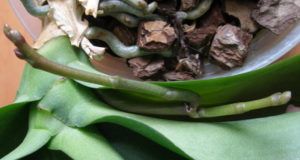 How to make an orchid release several peduncles? The orchid will not produce more than 3 peduncles. More often, one shoot is released, on which flowers bloom.
How to make an orchid release several peduncles? The orchid will not produce more than 3 peduncles. More often, one shoot is released, on which flowers bloom.
But if the flower is old enough and has 8-10 leaves in its outlet, then there is a probability of 2-3 peduncles appearing.
But this is stress for the plant and sometimes after such an abundant flowering, there is a breakdown in orchid plants. But in our conditions, which are often created even by experienced flower growers, more than 2 peduncles do not appear on flowers.
How to distinguish a root from a peduncle in an orchid?
A flower grower who takes care of his pet always wants to know how to determine if a peduncle or root is starting to grow in his ward:
- when a flower shoot appears, the care of the orchid changes;
- if the flower is in reanimation, the flower arrow is removed so that it does not delay the strength of the flower for its growth;
- well, and just wondering what it seemed on my plant.
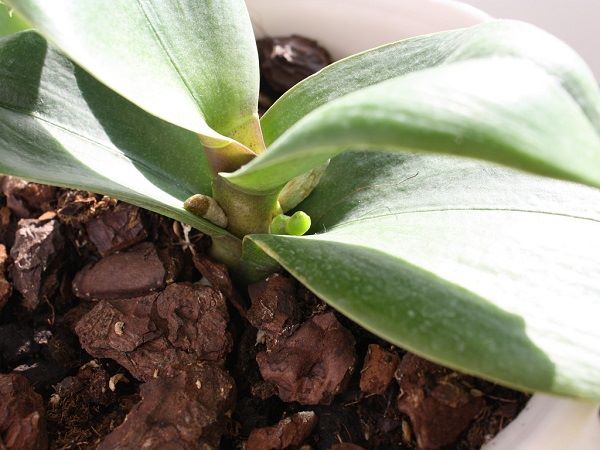
When a flower arrow appears, the care of the orchid should be changed.
The peduncle can develop in any bizarre way - grow downward or twist in a spiral. But so that it grows evenly, it is fixed with a special plastic holder.
Arrow structure
A young flower branch always begins to grow only from the leaf axils. Less often it is shown from the point of growth, but at the same time such a peduncle destroys this point and the orchid stops growing and it will need resuscitation.
In this case, the shoot has a flatter shape, and the tip is always pointed and has a stepped shape. No matter how he wriggles, he will still end up turning towards the sunlight. It should be remembered that the flower branches have a scaly coating.
Sometimes, with proper care, waiting buds wake up on the old peduncle and begin to grow. The budding florist gets lost so it can grow. In this case, it is a side flower branch or baby. Other parts of the plant do not grow in these places.
IMPORTANT! It sometimes takes 2-3 months from the emergence of the shoot to the opening of the first buds.
The main distinguishing features
The shoot is easy to distinguish from the root starting its growth, you just need to carefully look at the sprout. And the distinctive signs will indicate that the beginning of its growth.

It is usually easy to determine what exactly is growing - a peduncle or a root (close-up photo).
By color
The color of the flower shoot is dark green or brown. The roots have a light green tint, sometimes gray from lack of moisture.
At the place of germination
The flower shoot always emerges from the axil of the leaf plate.Where the leaf is attached to the trunk. The roots can be located around the entire perimeter of the orchid root collar.
In the direction of growth
The direction of growth is not an indicator, since both shoots can sometimes be located and reach for light or moisture, and at the same time grow in different directions.
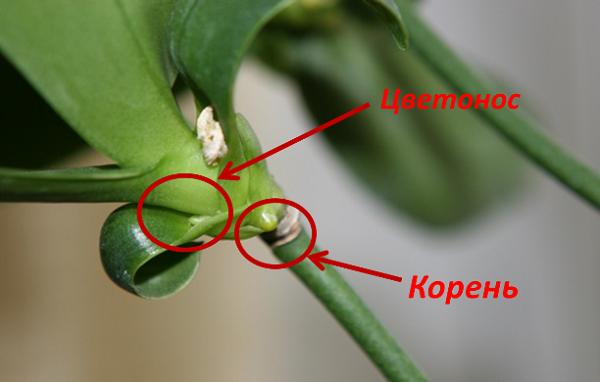
Both the root and the peduncle can grow in different directions.
IMPORTANT! Having found the differences once, then it will be impossible to confuse what appeared on the orchid: a future sprout with buds or another root.
Appearance process
These processes have their own significant differences. The roots appear quite often, but the flower shoot is the long-awaited result of proper care of your orchid.
Flower shoot
First, a small growth appears between the leaf plate and the trunk, which stretches out with each passing day. And the growth takes place towards the source of sunlight. On the emerging shoot, a scaly cover.
The arrow develops rapidly and therefore already on the 5th day you can be sure that it develops from the kidney.

The appearance of a peduncle.
Root
A root sprout emerges from the trunk anywhere, more often where there is no leaf. A shoot with a circular cross-section grows from the tubercle. In this case, the tip of the shoot is pointed and has a distinctive brighter color. This tip lengthens and grows in the direction of moisture. It should be remembered that the velamen covering the sprout has a smooth, homogeneous structure.
IMPORTANT! Even a beginner in the cultivation of orchids can distinguish the flower stalk itself from the root, the main thing is to take a closer look at the new sprout.
Dendrobiums
Dendrobiums are sympodial orchids consisting of several pseudobulbs growing very tightly to each other. Each pseudobulb is divided into segments, where leaves grow, as if clasping this place.
Plants sold in stores are of two types: Dendrobium-Nobile and Dendrobium-Phalaenopsis. Outwardly, they are very similar - they bloom in different ways.
- Where the leaves encircle the pseudobulb, Dendrobium-Nobile has buds, which under some conditions can be floral, and under others, children grow up in these places, depending on the conditions of detention.
- In Dendrobium-Phalaenopsis, the peduncle grows from the top of the pseudobulb.
Both species can bloom only after the bulb is ripe, i.e. when the young sprout rounds out and the last leaf grows on its top.
In order for Nobile to grow exactly flower buds, three conditions must coincide:
- Cool, up to 16 degrees.
- Very good lighting.
- Compliance with the winter dormant period, i.e. keeping the plant without watering.
If some condition is not met, then children will grow up on the pseudobulb. It is easy to distinguish them from peduncles - they look like hare ears.
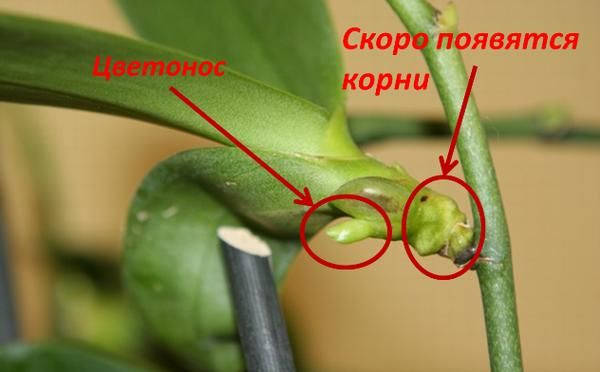
Is it possible to cut a peduncle
For several years, flowering arrows can produce flowers more than once. Other individuals fade and dry, giving way to new shoots. You should not rush to remove the peduncle that has immediately lost its decorative effect, despite its unpresentable appearance. While maintaining the green tone, the flower stem is not touched.
Signs will tell you whether it's time to remove the shoot:
- fast yellowness of a green peduncle or its acquisition of brown, red, purple colors;
- complete drying of the arrow;
- the green flowering arrow does not bud for 6 months.
The flowering shoot needs to be cut off, a 3 cm shoot is left, which comes out of the leaf sinus. For cutting use:
- scissors;
- pruning shears;
- with a sharp knife.
Flower pruning
The preferred tool is a pruner, which causes minimal damage to the orchid.
Advice. It is forbidden to pull out a dried flower-bearing arrow.
Cambria
Cambria is the commercial name for hybrids of oncidium group orchids. Oncidiums are sympodial plants consisting of flat pseudobulbs connected by a rhizome. It can be so short that it feels like a bundle.
The Cumbrian peduncle appears at the base of a ripe young bulb from under the second pair of covering leaves. You definitely cannot confuse it with the root, but at the initial stage it is easy to confuse it with new growth, which appear not only from under the first pair. There are hybrids in which the peduncle begins to grow even at the stage of development of a young pseudobulb.
Attention! It is necessary to remove peduncles from Cambria as soon as the first signs of wilting appear. Flowers quickly begin to rot, which can negatively affect the lower part of the plant .. One bulb can have only 2 peduncles and the old orchid will never bloom
If something appeared in a pseudobulb that had matured earlier, then this is definitely a new growth.
One bulb can have only 2 peduncles and the orchid will never bloom from old ones. If something appeared in a pseudobulb that had matured earlier, then this is definitely a new growth.
After the young bulb has matured, it is advisable to keep Cambria dry and in cool conditions. Water only when the pseudobulbs begin to wrinkle.
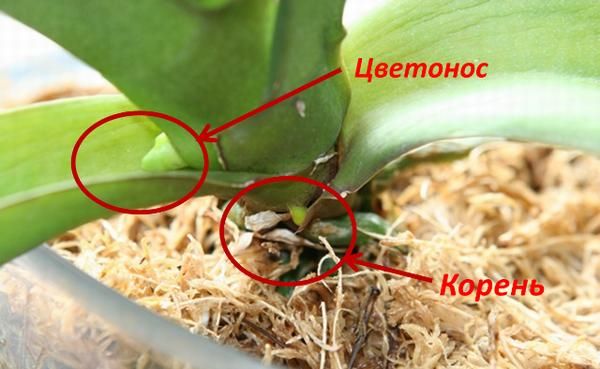
Possible problems
There are cases when a peduncle grows for a long time, it develops incorrectly or is completely absent. How to solve the problem, what measures to take in such cases?
In mature or already old plants, after numerous flowering, the flower branch can grow from the growing point. In young animals, this phenomenon is a consequence of stress.
In this case, nothing needs to be done. You should wait until the flower adapts after stress, all that remains is to observe and take care of it in time. Such an arrow can still form buds and bloom for a long time.
Advice!
Do not try to wrap the fracture site with a bandage or other material, in the hope that the stem will grow together. On an orchid, the arrow may dry out soon.
If the flower is "lazy" and has not thrown an arrow for a long time, then you can hurry it up with a pasture of escape. A gentle shake will help get the phalaenopsis to shoot the arrow. Florists provoke the appearance of a peduncle in an orchid that has been resting for more than a year.
Actions:
- transfer the orchid to a shaded place;
- reduce the number of waterings, but avoid drought;
- at night, lower the air temperature by 5 degrees, open the window for a short time, but without drafts;
- shake is carried out for about a week, then the pot is placed in the usual setting for a flower.
It happens that the arrow has grown, released several buds, and then stopped growing and new buds do not appear. Why did it happen and what to do in this situation.
What to do:
- inspect the plant, make sure that there is no disease, rot, insects;
- Does the beauty have enough - light, watering, humidity, fertilizers;
- if after treatment the stem does not begin to grow, then you need to wait until the phalaenopsis wakes up and continues to grow.
Orchid aerial roots
Why aren't they there?
At home in the tropics, orchids use only aerial roots, they are able to absorb moisture from the air. An epiphytic form of existence is when plants on a tree feed on microelements from the air. Without using the nutrition of the plant on which they are located.

In nature, all orchid roots are airy.
In the conditions of the apartment, the plants have adapted to a special soil. And if you are wondering why the orchid does not have aerial roots, then they have sunk into the substrate due to the conditions of detention.
Why are there many aerial roots?
Now we will find out why there are many aerial roots. Often, ground roots of orchids grow actively and quickly. This is due to the air being too dry. The plant is simply hot and, thanks to the formation of new aerial roots, it receives more moisture from the air.
Can they be put in a pot?
 There is no need to remove or remove new roots in the pot (beginners often do just that). In particular, you should not transplant when an extensive aerial root system appears.
There is no need to remove or remove new roots in the pot (beginners often do just that). In particular, you should not transplant when an extensive aerial root system appears.
The formation of new ground roots in Phalaenopsis is a normal, natural phenomenon.
It is recommended to cover new growths with moss to maintain moisture.
How to distinguish aerial roots:
From peduncles
At first glance, you can find similarities between the peduncle and the root when they appear. On closer inspection, they show a big difference. Their common features: when they appear, they form a gap at the base of the leaf.
So, how to distinguish flower stalks from aerial roots:
- the place where the sprout appears is examined: if it emerges from the stem and is located on the root collar between the leaves, this is an aerial root, the flower arrow appears in a different way;
- the next significant difference is the direction of growth. The roots incline the shoot downward. The arrow points up;
- differences exist in color;
- also distinguish sprouts by the tip of growth. The root anlage is rounded, obtuse, with a smooth surface. The arrow has the smallest scales, flower buds will develop under them, and the peduncle also has a pointed end.
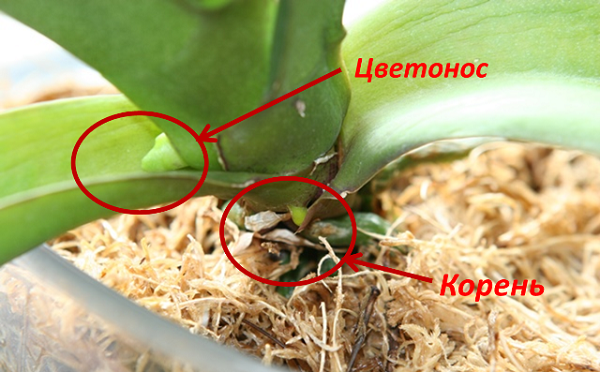
Photo, how to distinguish the root from the peduncle.
From common roots
In an orchid, all roots are the same, so the question "How to distinguish roots from aerial roots?" doesn't make much sense. It is normal for multiple aerial roots to form above the soil.
The roots that are above the ground are thicker than those in the ground. If ground roots are not visible on the plant, then, most likely, when they appear, they deepened into the substrate.
Can you trim?
Sometimes beginner growers cut off ground roots, considering this phenomenon a sign of improper plant development. This is a rather imprudent action.
As a rule, the roots are not cut unless there is a good reason. Pruning is carried out in case of root death due to the following reasons:
- decay;
- drying out;
- withering away.
If the roots are healthy and have a greenish-silver color, then this should not be done.
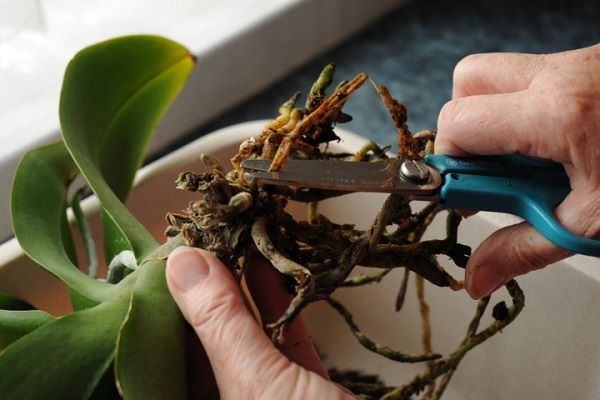
Only dead roots can be trimmed.
Reproduction
Only sympoidal plant species are suitable for reproduction in this way.
For reproduction, the roots of the flower must be healthy and have several pseudobulbs. The success of the division depends on the number of pseudobulbs. You can propagate by aerial roots. Young roots are green in color, over time they become greenish-silvery.
For the purpose of reproduction, a strong, healthy, formed root is taken.
Attention! It is impossible to reproduce during flowering and after dropping flowers.
The peduncle is removed before reproduction. This procedure is done with a sterile sharp knife, then it is recommended to sprinkle the cut points with charcoal.
Read more about propagation with aerial roots here.
What to do with them?
 This question is of interest to many flower growers when they observe an abundant growth of the ground root system. If there are 1-3 aerial roots, then this is considered the norm, then the right conditions have been created for the plant.
This question is of interest to many flower growers when they observe an abundant growth of the ground root system. If there are 1-3 aerial roots, then this is considered the norm, then the right conditions have been created for the plant.
Removing the roots injures the orchid, is the cause of the pathological microflora. These actions lead to a lack of nutrients for the flower.
By changing the water regime, you can bring the number of ground roots back to normal.
You can find more information on what to do with aerial roots here.
How to care for an orchid
The dormant period for the orchid ends in autumn. Adequate lighting, feeding and regular watering are the basic principles of caring for a flower. Comprehensive care will allow you to get the long-awaited peduncle in a short time. Fresh air is required, drafts must not be allowed. Humidity in the house is 60-70%.
Phalaenopsis orchid is moisture-loving. In winter, due to radiators and batteries, and in summer, due to the scorching sun in the apartment, the air becomes dry. The substrate should not be allowed to dry, watering is necessary when the soil becomes slightly damp.
When the orchid has released the flower stalk, watering is gradually reduced, spraying directed at the plant is not desirable, this can destroy the new shoot.Between watering, the planting mixture should dry for at least 5 days, the break gives the root system time for photosynthesis. If before the formation of the stem, the flower was watered 1-2 times a week, now it is necessary to water the orchid 3-4 times a month.
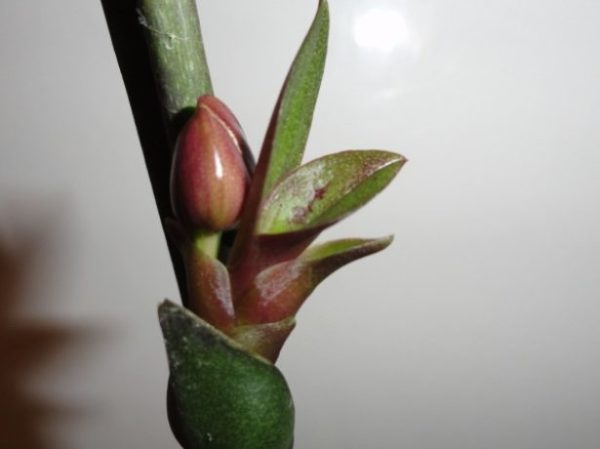
For any orchid, flower stalks in the amount of three or more at once are a great exhaustion and shock. The energy is spent on the formation of stems, on the appearance of buds and on the blooming of beautiful flowers. After abundant flowering, the flower needs peace and good care.
Peduncle propagation is more effective than seeds
The cut arrow of the plant is used to grow a flower at home. This method is considered to be more effective than seed propagation. Breeding an orchid with a peduncle is carried out in two ways.
Stem cuttings
This procedure is carried out in late spring or early summer. Cuttings are cut in this way:
- The lower leaves are cut off.
- Sections are sterilized with activated carbon.
- The plant is fertilized with nitrogen fertilization.
- After the formation of roots on the cuttings, the shoot is cut off.
After cutting, the peduncle must be planted in prepared soil. Within two days, a young orchid cannot be watered so that the plant can take root. After 2-3 months, the flower will grow
It is important to ensure that the stalk does not break during cutting.
Growing in water
The sequence of the procedure:
- The stalk is placed in a bottle, after cutting off the neck by 5 cm.
- The container is filled with water with the addition of activated carbon. The shoot should be 4-5 cm in the water.
- The razor cuts off the scales on the arrow to awaken the kidney
- The cut site is treated with cytokinin ointment.
If the shoot is broken, then the place of the break is cut off. The ointment is applied every week for a month. The liquid in the bottle is changed once a week. After 3 weeks, the plant develops a developed root system and can be planted in a pot.
One plant can bloom a great variety of flowers at the same time. It is necessary to provide proper care of the orchid before the ejection of the peduncle, during the flowering phase and during the rest of the plant.
When the plant has given a peduncle, it should be properly looked after:
- Maintain high humidity (60-70%).
- Fertilize your orchids regularly.
- Grow in clear pots or blocks.
- Provide enough light. In winter and in the off-season, use phytolamps.
- Do not move or rotate the plant pot.
- Recreate the temperature regime, as in the tropics (the difference between day and night temperatures is important: in the daytime 20-24, at night 15-18 degrees).
The peduncle should not be allowed to remain in a draft and be exposed to too warm a stream of air.
While the orchid is in bloom, it must not be repotted. During the development of the peduncle, watering is carried out according to the usual scheme: they are sprayed with warm water only before lunch. After it is not desirable. With the onset of flowering, watering is reduced.
It is necessary to support the peduncle so that it does not break under the weight of large flowers. There are special supports for orchids on sale.
Thus, the peduncle of an orchid is formed in the axils of the leaves. It is characterized by a pointed round tip, scaly structure. Shoot shape is flattened and flat. The flowering bud is directed upwards, sometimes sideways.
If you find an error, please select a piece of text and press Ctrl Enter.
Difference from root baby
Experienced flower growers know that in addition to roots and peduncles, children can develop on orchids. Sometimes they appear on peduncles, but under certain circumstances, children can develop in other places.
One of these places is its root location.
Important! A basal baby is easy to confuse with a peduncle.
The phalaenopsis arrow and the baby have one place of growth, they tend to develop from the leaf sinuses, and at the very beginning of development they are visually very similar. It manifests itself in the form of an escape, and in color, and in the presence of scales.
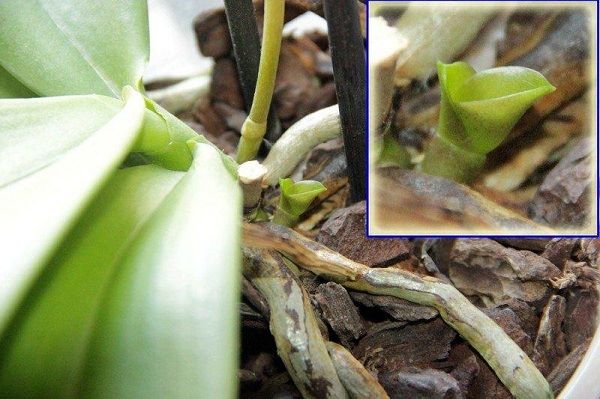
Root baby.
The appearance of a baby, including a basal one, is usually preceded by the following indicators:
- complete absence of a growth point;
- instead of a sheet, an arrow went from the top;
- the plant is quite old, over 6 years old.
Each of these signs indicates that a baby will appear at the trunk in the near future. Moreover, the absence of a growth point is most often characterized by the appearance of a basal sprout.
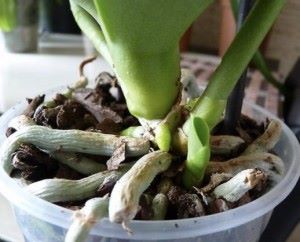 But besides the similarity, these two neoplasms also have a number of differences. How to distinguish a peduncle from a baby:
But besides the similarity, these two neoplasms also have a number of differences. How to distinguish a peduncle from a baby:
- the similarity of the shape of the shoots at the very beginning of development is lost, the baby takes the shape of a boat, gradually a depression appears in the middle of it;
- his scales are much smaller, they hardly develop during the growth process;
- after a couple of weeks, the arrow will become longer, the baby will begin to release the first leaves.
Based on this, it will be possible to determine what grows in the orchid.
Wandas
Wandas are monopodial epiphytic plants. In their structure, they are similar to Phalaenopsis, but there are a number of differences in care and maintenance. Vandas have more powerful roots, which grow stiff with age and can reach two meters in length. How to tell if roots or stalks are growing in Wandas?
The peduncles of the Wands can be seen immediately, it is rather difficult to confuse them with the roots. They look like tadpoles; in good light, watering and feeding, they grow intensively. Like Phalaenopsis, during the period of peduncle growth and flowering, they are prone to rot when moisture stagnates in the leaf axils.
Far from blooming from every sinus leaves. With a lack of light, the peduncle is easily dried.



